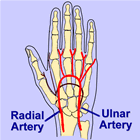| << To Blog Home >> | |
|
|
September 14, 2010 -- 6:25pm EDT Training for the Transradial Approach
to Angioplasty and Stents These are major U.S. meetings, but there are other training opportunities around as well -- for example, Tejas Patel's annual TRICO meeting in Ahmedabad, India is scheduled for October 30-31. It is the meeting where a number of American interventionalists first learned the technique of angioplasty via the wrist and brought it back to the U.S. And renowned cardiologist Dr. Shigeru Saito's Kamakura Live Demonstration Course in Japan is being held in early December. If you are interested in learning the transradial approach to coronary diagnostic and treatment, visit Angioplasty.Org's page on "Transradial Training Courses" for information on upcoming training opportunities; and, if you are offering such a course, and it is not listed, please send us the information via our "Transradial Course Submission" page. The transradial wrist approach is used 50% of the time in many countries, but at last look less than 5% in the U.S. I predict that the next time these figures are published, we'll be seeing closer to 10% in the U.S. And here's why:
Yes, we're talking about a procedure for the heart...but if you look at the data, it's a no-brainer! |
|


 Yesterday
I wrote about the
Yesterday
I wrote about the